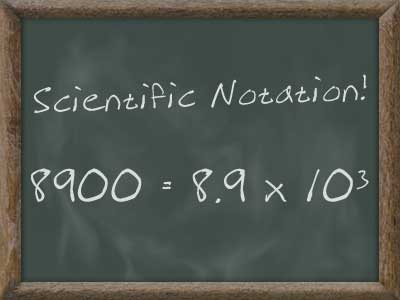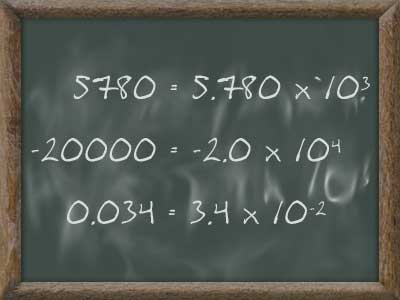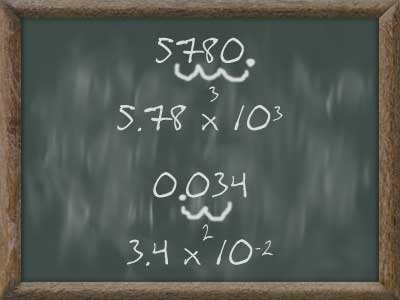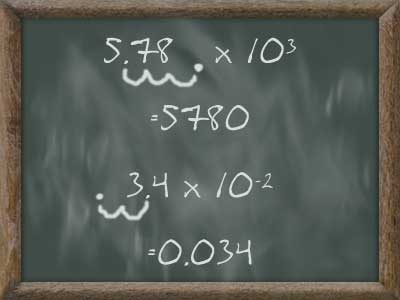What is Scientific Notation?
Scientific notation is a style of writing numbers that are too large or too small to be expressed well by the common decimal notation. In scientific notation the decimal place is moved until only one number appears on the left side of the decimal. The number of places the decimal had to be moved is recorded using an exponent above a base of ten. (The terms standard form or exponential notation also refer to scientific notation.)

A typical decimal number expressed in scientific notation
Why Use Scientific Notation?
When dealing with numbers that are either very small or very large it can be difficult to express these in standard decimal notation. For example the number one billion 1,000,000,000 has many zeros. In science and engineering particularly even larger or smaller numbers occur often and writing so many zeros would be difficult and could lead to errors.

Examples of some typical decimal numbers in scientific notation
Okay so in the numbers above moving the decimal isn’t a huge headache saving strategy, but as numbers grow or shrink much further this new style of notation becomes essential.
How to Convert a Decimal to Scientific Notation:
- Move the decimal left or right as many places as required until there is only one number to the left of the decimal.
- The number of places you had to move the decimal is your exponent.
- The direction you had to move the decimal, left or right, determines if your exponent will be positive or negative.
- Moving the decimal left means a positive exponent.
- Moving the decimal right means a negative exponent.
We always want to move the decimal left or right one whole spot at a time, because our numbering system is base ten this means the base of the exponent must be ten. Check the example below for the final rewrite.

Examples of Converting a Decimal Number to Scientific Notation
a. In the first example above the decimal is moved three places to the left. The decimal number 5780 can be rewritten as 5.78 x 10^3. Three is the exponent because this is how many places the decimal had to move. The exponent is positive because the decimal moved to the left.
b. In the second example above the decimal moves two places to the right. The decimal number 0.034 can be rewritten as 3.4 x 10^-2. The decimal moves two spaces so this is the exponent and it moves right so the exponent is negative.
How to Convert Scientific Notation to Decimal:
- Move the decimal the number of places indicated by the exponent.
- Again, the direction you’ll move the decimal depends on the exponent being positive or negative. When converting from scientific notation to decimal move in the opposite direction. Positive exponents move the decimal right and negative exponents move the decimal left.

Examples of Converting Scientific Notation to Decimal
a. In the first example our number in scientific notation is converted back into a decimal. The exponent is three so the decimal must move three places. In this case we are going from scientific notation to decimal so move the decimal place right for a positive exponent. Note: You can always approach the problem literally. 10^3 is the same as 1000. 5.78 x 1000 is 5780, the correct answer.
b. In the second example we can see the decimal must be moved two places. The numbers is changing from scientific notation to decimal so a negative decimal place indicates we must move the decimal to the left.
Scientific Notation on Calculators and Computers
Calculators and computers need a special way to represent scientific notation. You may have already seen this special notation used on really really large numbers in the online calculator. On calculators especially placing a power floating in the air above the line is too challenging so instead an exponent is represent with the letter “E”. To save even more space the multiplication symbol and base of ten are dropped completely and everything is simply replaced by “E”.
For example 5.78E3 or 5.78e3 are the same as 5.78 x 10^3. If the exponent is negative it is written 3.4E-2 or 3.4e-2. Depending on the device the “E” may be upper or lower case.
Hope this helps, Good Luck.